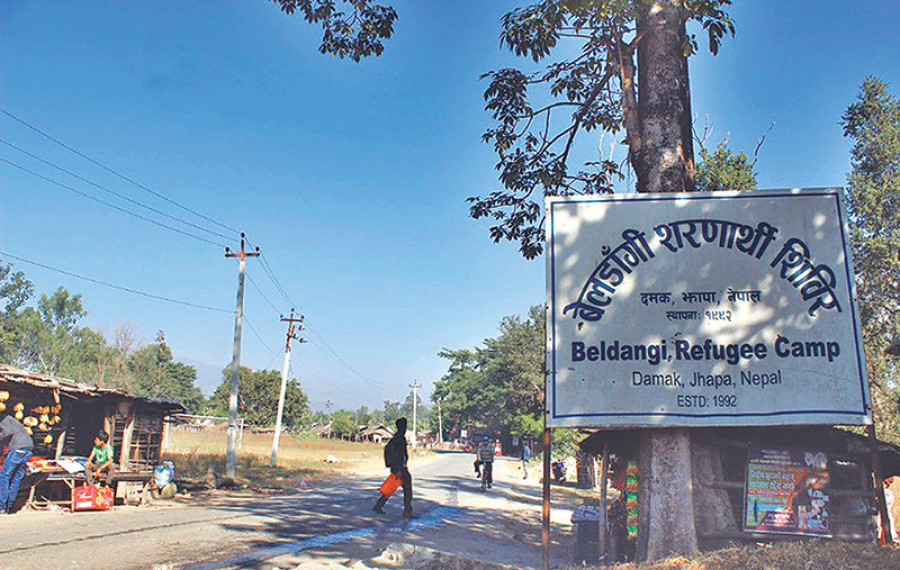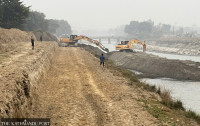National
No solution yet for 8,500 Bhutanese refugees in Nepal
As the decade-long third country resettlement programme of the Bhutanese refugees living in eastern Nepal draws to a close, the fate of the those still in the camps hangs in the balance.
Anil Giri
As the decade-long third country resettlement programme of the Bhutanese refugees living in eastern Nepal draws to a close, the fate of the those still in the camps hangs in the balance.
The Ministry of Home Affairs (MoHA) and the UN refugee agency in Kathmandu confirmed that the third country resettlement scheme is closing down after the last batch of refugees leaves by the end of December.
Currently there are around 8,500 refugees in the camps in Jhapa district but both sides—Nepal government and the UNHCR—have yet to find alternatives for them.
There was pressure on Nepal government to locally assimilate the refugees in Nepal, but Kathmandu has been constantly saying that these refugees should be repatriated to Bhutan.
Narayan Prasad Sharam, spokesperson at for MoHA, told the Post that though the official communication is yet to be made by the UNHCR, during informal meetings, the officials have mentioned that the third country resettlement programmes would end after the last batch of refugees leaves in December.
Around 2,000 refugees are undergoing screening process to leave for the third country under the resettlement programme in various western countries. The UNHCR stopped submitting Bhutanese refugee cases for consideration by resettlement countries on December 31, 2016, and the large-scale resettlement programme has concluded, the UN refugee agency said in a response to the Post’s query.
Nearly nine out of 10 Bhutanese refugees (90 percent) have been resettled since the launch of the third country resettlement programme in 2007, with nearly 111,000 refugees resettled in eight different countries. “Globally, far less than 1 percent of refugees are resettled. Thus, the resettlement programme for Bhutanese refugees in Nepal is truly exceptional,” the office said. The UNHCR, together with the international community, is working closely with the government of Nepal to find solutions for the remaining refugees, the UNHCR added. According to the UN office, with nearly 111,000 refugees resettled in third countries and only 8,500 of them remaining in Nepal, the opportunities to achieve durable solutions at this juncture are great.
The UNHCR and representatives of various countries in Jhapa district recently communicated to the refugee community that that third country resettlement programme would come to an end this year. During a meeting between the UNHCR, Damak office in Jhapa and refugee representatives on Wednesday, where camp secretaries from the refugee community of Pathari and Beldangi were present, UNHCR officials said that the third country resettlement is going to close down soon and stressed for local assimilation of refugees.
The UNHCR officials also said in the meeting that though efforts are underway to repatriate the refugees to Bhutan, chances are very slim. In the two camps of Jhapa, some cases which were submitted by the UNHCR before December 31, 2016 are still undergoing medical screening and additional assessment by resettlement countries. After completing the process, some 2,000 refugees will leave for third country resettlement. Series of information campaigns were conducted since 2014 in the camps to ensure that the refugees are well informed about the deadline, the UNHCR said.
In response to what alternative has been thought about the remaining numbers of refugees, the UNHCR said: “A small number of refugees remaining in Nepal, either wish to return to Bhutan or integrate locally. Bhutanese refugees share many cultural, linguistic and religious links with Nepal—and a significant number of Bhutanese refugees are married to Nepali citizens and have had children together.”
They are well-educated, hard-working and ready to more fully contribute to Nepali society, as demonstrated by their support of the earthquake response in 2015 and during the floods in the Tarai region during monsoon in 2017, the UN refugee agency said. UNHCR, in partnership with the government of Nepal and development partners, are working towards finding alternative durable solutions for the remaining refugees while promoting self-reliance and empowerment, the office said. UNHCR is also continuing to encourage dialogue between the governments of Nepal and Bhutan to find solutions for the remaining refugees, it stated.
Quick facts
Approximately 120,000 Bhutanese fled from their country and arrived in Nepal to become refugees from Bhutan in the early 1990s
They were lodged in several camps in Jhapa in eastern Nepal
The third country resettlement programme was launched in 2007
In the last one decade, nearly 111,000 refugees from Bhutan have been settled in various western countries, with the US alone receiving more than 90,000 of them
Nearly 2,000 refugees are currently undergoing screening process under the third country resettlement programme
The UN refugee agency says it is set to close down the third-country resettlement programme by early next
The last batch is likely to leave in December after which an estimated 8,500 Bhutanese refugees will remain in Nepal




 13.12°C Kathmandu
13.12°C Kathmandu















